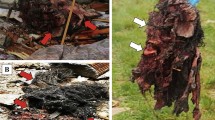Abstract
The Abbreviated Injury Scale (AIS) and Injury Severity Score (ISS) are important evaluation tools used in clinical practice to determine the degree of injury in patients with trauma. However, they are not suitable for forensic practice and their use in forensic applications is limited. This study aimed to present a system that can objectively and quantitatively determine the severity of postmortem injuries and that can be applied to forensic medicine. Subsequently, we applied this system to individual postmortem cases and analyzed the injuries identified during autopsy. We performed a retrospective study of 119 autopsies performed between 2018 and 2021. Data were categorized and analyzed using the Forensic Injury Severity Score Template (FISST), a scoring system developed based on the AIS and ISS. The mean FISST scores were as follows: men, 53.6; women, 46.8; 20–65 years old, 55.6; older than 65 years, 41.4; natural death, 13.8; unnatural death, 66.3; and all deaths, 51.8. Statistically significant differences in the FISST scores were found between natural and unnatural deaths, suicidal and accidental deaths, and trauma-related death subtypes. Injuries identified during autopsy can be objectively and quantitatively evaluated using FISST. We suggest that FISST is a useful tool in forensic medicine because it is tailor-made for injury evaluation from a postmortem perspective.




Similar content being viewed by others
Data availability
All data generated or analyzed during this study are included in this published article (and its supplementary information files).
References
Höke MH, Usul E, Özkan S. Comparison of trauma severity scores (ISS, NISS, RTS, BIG Score, and TRISS) in multiple trauma patients. J Trauma Nurs. 2021;28(2):100–6.
Li H, Ma Y. New injury severity score (NISS) outperforms injury severity score (ISS) in the evaluation of severe blunt trauma patients. Chin J Traumatol. 2021;24(5):261–5.
Hsu S, Wu S, Rau C, Hsieh T, Liu H, Huang C, et al. Impact of Adapting the abbreviated injury scale (AIS)-2005 from AIS-1998 on injury severity scores and clinical outcome. Int J Environ Res Public Health. 2019;16(24):5033.
Bono C, Vaccaro A, Hurlbert R, Arnold P, Oner F, Harrop J, et al. Validating a newly proposed classification system for thoracolumbar spine trauma: looking to the future of the thoracolumbar injury classification and severity score. J Orthop Trauma. 2006;20(8):567–72.
Zhang J, Zhang Y, El-Maaytah M, Ma L, Liu L, Zhou L. Maxillofacial injury severity score: proposal of a new scoring system. Int J Oral Maxillofac Surg. 2006;35(2):109–14.
Subedi N, Yadav B, Jha S. Application of abbreviated injury scale and injury severity score in fatal cases with abdominopelvic injuries. Am J Forensic Med Pathol. 2014;35(4):275–7.
Hitosugi M, Maegawa M, Motozawa Y, Kido M, Kawato H, Nagai T, et al. Analysis of cervical injuries in persons with head injuries. Am J Forensic Med Pathol. 2008;29(1):23–6.
Radojevic N, Curovic I, Atanasijevic T, Lazovic R. Injury severity score based estimation of height of fall in bus rolling down the cliff. J Forensic Leg Med. 2015;34:133–8.
Takeda A, Hitosugi M, Furukawa S. Autopsy cases of motorcyclists dying of trauma or disease. Am J Forensic Med Pathol. 2017;38(3):222–5.
Pomara C, Turillazzi E, Neri M, Bello S, Di Donato S, Riezzo I, et al. A multidisciplinary approach to the investigation of a collapsed building. Am J Forensic Med Pathol. 2010;31(3):264–8.
Boudreau R, O’Neal E, Besl K, Gordon S, Ralston W, Elterman J, et al. Do autopsies still matter? The influence of autopsy data on final injury severity score calculations. J Surg Res. 2019;233:453–8.
Marini C, Petrone P, Soto-Sánchez A, García-Santos E, Stoller C, Verde J. Predictors of mortality in patients with rib fractures. Eur J Trauma Emerg Surg. 2021;47(5):1527–34.
Li F, Liu S, Lu X, Ou Y, Yip P. Application of the injury scales in homicides. Forensic Sci Int. 2018;292:83–9.
Yurtseven A, Üzün İ, Arslan M. Suicides by jumping off Istanbul bridges linking Asia and Europe. Am J Forensic Med Pathol. 2017;38(2):139–44.
Funding
This work was supported by Pusan National University Research Grant, 2022.
Author information
Authors and Affiliations
Corresponding author
Ethics declarations
Ethics approval
This study used the data of forensic autopsies requested by the public prosecutor with Court approval. The study was confirmed as a research activity qualifies as nonhuman participant and as all data were analyzed anonymously.
Human participants and animal studies
This article does not contain any studies with human participants or animals performed by the authors.
Conflict of interest
The authors declare no competing interests.
Additional information
Publisher's Note
Springer Nature remains neutral with regard to jurisdictional claims in published maps and institutional affiliations.
Rights and permissions
Springer Nature or its licensor (e.g. a society or other partner) holds exclusive rights to this article under a publishing agreement with the author(s) or other rightsholder(s); author self-archiving of the accepted manuscript version of this article is solely governed by the terms of such publishing agreement and applicable law.
About this article
Cite this article
Kim, D.G., Choi, HS., Lee, T.H. et al. Postmortem injury evaluation using the Forensic Injury Severity Score Template (FISST): a preliminary study. Forensic Sci Med Pathol 19, 484–498 (2023). https://doi.org/10.1007/s12024-023-00583-9
Accepted:
Published:
Issue Date:
DOI: https://doi.org/10.1007/s12024-023-00583-9




